Gyros
- By Jennifer Segal
- Updated June 27, 2025
- 71 Comments
- Leave a Review

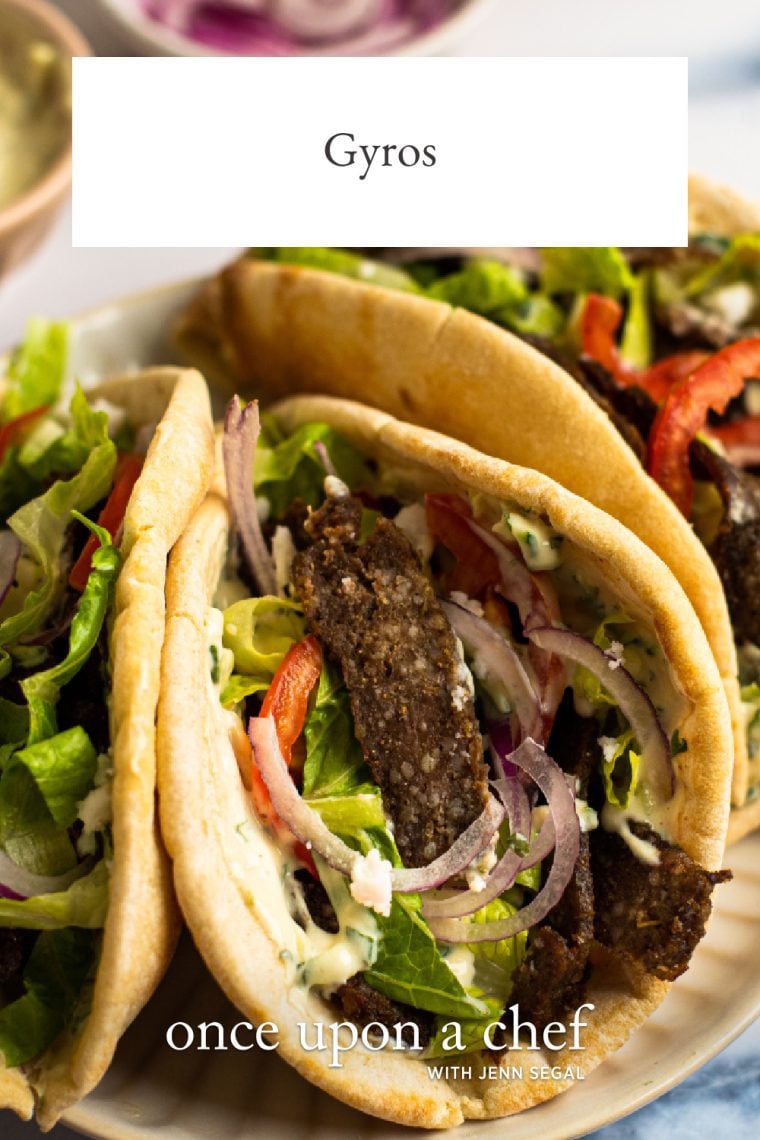
This post may contain affiliate links. Read my full disclosure policy.
Yee-roh or ji-roh? No matter how you say it, a Greek gyro is all about juicy, seasoned meat, warm pita, and cool tzatziki—plus whatever fresh toppings you love. This easy recipe lets you enjoy those flavors at home, whether for dinner tonight or freezer-friendly meal prep.
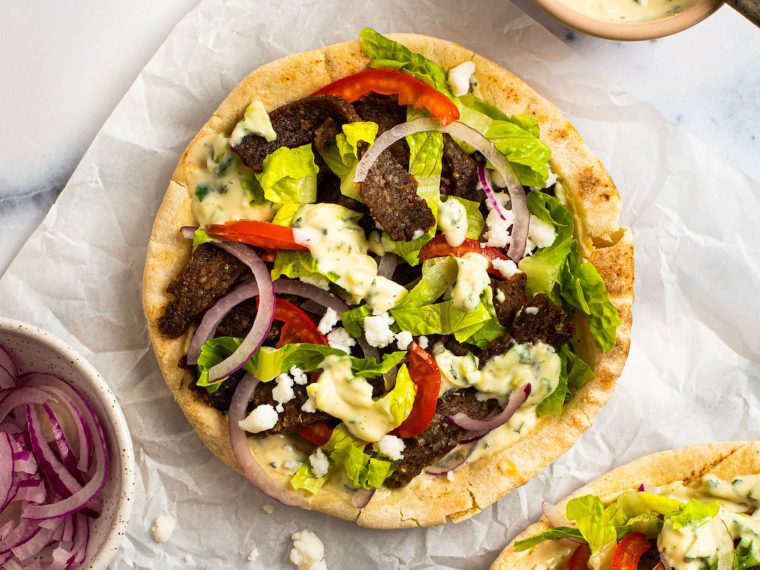
Chances are, you’ve enjoyed a delicious gyro, but have you been pronouncing it correctly? It’s actually yee-roh. (Do yourself a favor and watch this Jimmy Fallon/Luke Bryan clip about the pronunciation—it’s hilarious.) The Greek word gyro means “turn,” referring to the traditional method of slow-roasting meat on a vertical spit as it crisps and browns.
In Greek restaurants in the States, you’ll find two types of gyros: The Greek-American version, made from ground meats and spices formed into a cone and cooked on a rotisserie, and traditional Greek gyros, made with marinated whole cuts of meat that are stacked and roasted.
Both are delicious—but the Greek-American style is much easier to pull off at home. This Greek-American style recipe skips the rotisserie; you just shape the ground meat into loaves and bake them in the oven.
Homemade gyros are super flexible when it comes to serving! You can serve the meat over a Greek salad for a lighter meal or wrap the slices in a warm pita with tzatziki sauce, juicy tomatoes, crisp lettuce, and crumbled feta. Bonus: The recipe makes two loaves, so you can freeze one for another night.
“This recipe is very, very near the real thing…can’t wait for my next dinner !”
What You’ll Need To Make Gyros

- Ground Meat: This best gyro recipe uses both ground beef and ground lamb, the classic combo for that rich, savory gyro flavor you know and love.
- Plain breadcrumbs: Helps bind the meat mixture so it holds together nicely.
- Spices and seasoning: A flavorful mix of salt, black pepper, dried oregano, onion powder, garlic powder, and ground cumin gives the meat that classic gyro flavor.
- For serving: Pita bread, tzatziki sauce, sliced tomatoes, red onion, lettuce, and crumbled feta—mix and match to suit your taste. Note that you can find pita bread with and without pockets; if you plan to eat these as wraps, you’ll want to buy pocketless pitas.
- Jump to the printable recipe for precise measurements
How To Make Gyros
Step 1: Combine the ingredients. Add the beef, lamb, breadcrumbs, salt, pepper, oregano, onion powder, garlic powder, and cumin to the bowl of a food processor fitted with the steel blade.

Step 2: Blend. Pulse until the mixture is smooth, cohesive, and paste-like. Really blending it well ensures the meat holds together when sliced and gives it that signature gyro texture—tender, compact, and easy to crisp in the pan. You’ll need to scrape down the bowl a few times to make sure everything mixes evenly.

Step 3: Shape the gyro loaves. Shape the meat into two free-form loaves right on a foil-lined baking sheet. Each loaf should be about 1 inch high, 8 inches long, and 4 inches wide—they don’t need to be perfect, just evenly shaped so they cook uniformly.
Pro tip: Using moist hands helps keep the raw meat mixture from sticking to your hands and makes it easier to work with.

Step 4: Bake. Place the loaves in a 300°F oven for 40 to 45 minutes. The lower oven temp cooks the meat gently, helping it stay tender and juicy rather than drying out. Let the loaves rest for about 10 minutes before slicing. Once cool, you can refrigerate the unsliced loaf of meat for up to 4 days if you’re making them ahead or freeze for up to three months.

Step 4: Slice the meat. Transfer the loaves to a cutting board and thinly slice. If you sneak a taste (and you should!), you might notice the meat tastes a little salty on its own—that’s by design. You need the extra salt to be sure the flavor shines through once the meat is paired with pita, veggies, and sauce.
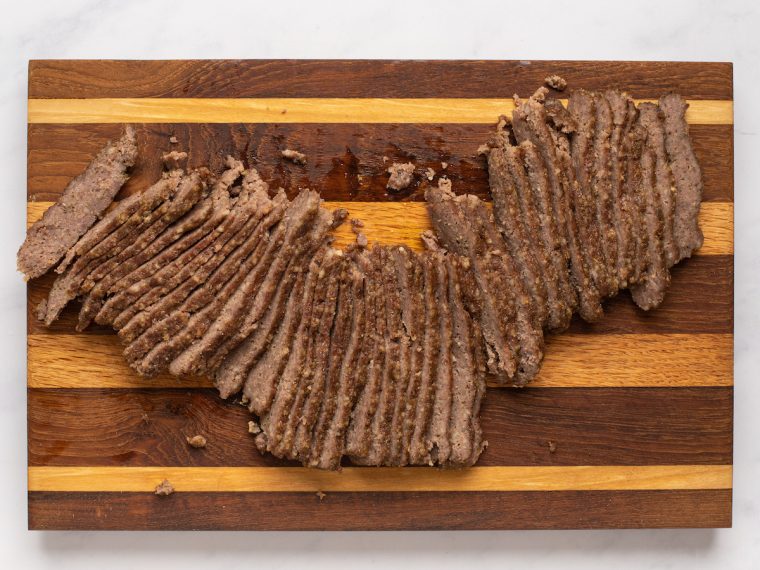
Step 5: Brown the meat. When you’re ready to serve, heat a little oil in a nonstick skillet over medium heat and cook the gyro slices in batches, in a single layer, until lightly browned. Browning adds that irresistible crispy edge and brings out even more flavor, just like you’d get from a traditional rotisserie.

Step 6: Assemble the gyros and serve. Pile the crispy slices of beef and lamb gyro meat into warm pita bread and top with tzatziki, tomatoes, onion, lettuce, and feta—or mix and match your favorite toppings.
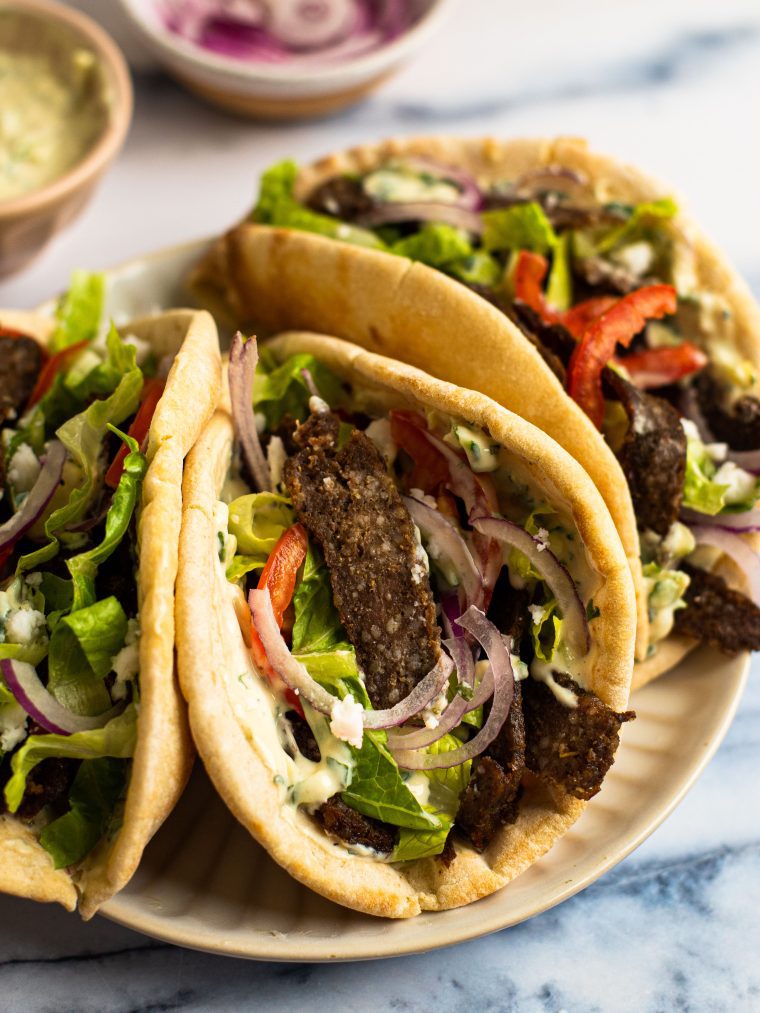
There’s lots of flexibility when it comes the best gyro toppings. You can stick with the classics or add some kalamata olives, sliced bell pepper, traditional hummus, tahini sauce, roasted red peppers, or a spot of harissa for a spicy kick to your gyro wraps.
You can also prepare a spread of other Mediterranean favorites such as falafel, baba ganoush, and whipped feta dip. Or for a meal, pair it with some crispy roasted potatoes!
More Greek Recipes You May Like
Gyros

Everything you love about a classic Greek gyro, made easy at home—perfect over a salad or wrapped in warm pita.
Ingredients
For the Gyro Meat
- 1 pound 80% lean ground beef
- 1 pound ground lamb
- ½ cup plain bread crumbs
- 1½ teaspoons salt
- 1 teaspoon freshly ground black pepper
- 2 teaspoons dried oregano
- 1 teaspoon onion powder
- 1 teaspoon garlic powder
- ½ teaspoon ground cumin
For Serving
- Olive oil
- Pita bread
- Tzatziki sauce
- Thinly sliced tomatoes and red onion
- Lettuce
- Feta cheese
Instructions
- Preheat the oven to 300°F and set an oven rack in the middle position. Line a baking sheet with heavy-duty aluminum foil.
- Place the beef, lamb, bread crumbs, salt, pepper, oregano, onion powder, garlic powder, and cumin in the bowl of a food processor fitted with the steel blade. Process until the mixture is well combined and paste-like, scraping down the bowl as necessary, about 1 minute.
- Using moist hands, form the mixture into two free-form loaves about 1 inch high, 8 inches long, and 4 inches wide directly on the prepared baking sheet. Bake for 40 to 45 minutes, or until meat is firm in the center and reaches an internal temperature of 160°F. Let sit for about 10 minutes, or chill until ready to slice, up to 4 days. Transfer the loaves to a cutting board and slice between ⅛ and ¼ inch thick.
- To serve, working in batches, heat about 1 tablespoon of oil in a nonstick skillet over medium heat. Cook the gyro slices in a single layer until lightly browned, 30 to 60 seconds per side. Serve with pita bread, tzatziki sauce, tomatoes, onion, lettuce, and feta.
- Make-Ahead Instructions: The gyro loaves (or unbrowned slices) can be prepared up to 4 days ahead of time and refrigerated, or frozen for up to 3 months. Thaw overnight in the refrigerator before browning and serving.
- Note: Nutritional information is for gyro meat only.
Pair with
Nutrition Information
Powered by ![]()
- Per serving (6 servings)
- Calories: 446
- Fat: 33 g
- Saturated fat: 14 g
- Carbohydrates: 8 g
- Sugar: 1 g
- Fiber: 1 g
- Protein: 27 g
- Sodium: 377 mg
- Cholesterol: 109 mg
This website is written and produced for informational purposes only. I am not a certified nutritionist and the nutritional data on this site has not been evaluated or approved by a nutritionist or the Food and Drug Administration. Nutritional information is offered as a courtesy and should not be construed as a guarantee. The data is calculated through an online nutritional calculator, Edamam.com. Although I do my best to provide accurate nutritional information, these figures should be considered estimates only. Varying factors such as product types or brands purchased, natural fluctuations in fresh produce, and the way ingredients are processed change the effective nutritional information in any given recipe. Furthermore, different online calculators provide different results depending on their own nutrition fact sources and algorithms. To obtain the most accurate nutritional information in a given recipe, you should calculate the nutritional information with the actual ingredients used in your recipe, using your preferred nutrition calculator.
See more recipes:
Comments
Add a Comment Cancel reply
This site uses Akismet to reduce spam. Learn how your comment data is processed.



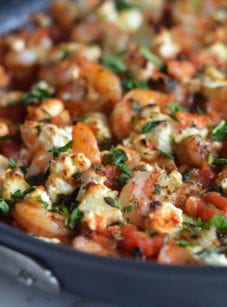
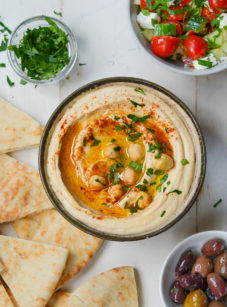
Been wanting to make this gyro recipe for three days now and had to go to multiple stores to find ground lamb. It’s Christmas Eve and I made the gyros for lunch today and just because it’s Christmas Eve I gave my dog Rosie the end pieces of the gyro loaves.
I don’t know who scarfed down these gyros faster, me or the dog. The gyro meat had just the perfect amount of fat to keep it juicy – 80% ground beef and the naturally fatty lamb stayed juicy even after the pan frying. That the recipe made two loaves allowed one to be frozen for a ready meal but the recipe itself is so easy and quick to make that it can be done in less than an hour total.
My loaves turned out a little more like a meatloaf size so next time I will pat them down more to resemble the picture.
Another recipe from OUAC that is fool proof (except for commenters who don’t read and follow the recipe and then leave a comment that it didn’t turn out right).
Can always count on Jenn to get it right and graciously answer all questions.
Happy Holidays
LOVED, LOVED, LOVED this recipe. I had family coming over for brunch and it was such a nice change from typical lunch fare. I baked the meat a day ahead, and just fried them up when the guests arrived. It was a huge hit and so flavorful. I served it with your cucumber salad and that was the perfect compliment to the gyros
I have made dozens of your recipes, Jen, and I can ALWAYS count on them being fantastic. Thanks again for another winner!!!
This was absolutely delicious! A huge hit with the whole fam!
This gyro texture and flavor is spot on, plus it’s incredibly easy to make. Thank you again for another flawless recipe.
Any thoughts on subbing ground chicken thighs for lamb? Lamb is a diet restriction for my husband.
Instead of ground chicken, I’d suggest using more ground beef or ground pork.